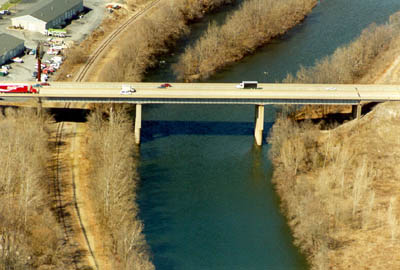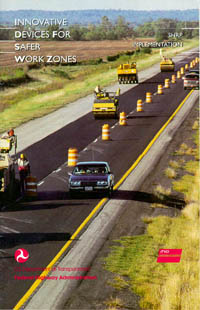U.S. Department of Transportation
Federal Highway Administration
1200 New Jersey Avenue, SE
Washington, DC 20590
202-366-4000
Focus
| Accelerating Infrastructure Innovations |
Publication Number: FHWA-SA-98-021
Date: April 1998

Motorists and workers in the work zones on U.S. Route 22 in Pennsylvania will be safer thanks to the infrared intrusion alarm and the queue length detector, two work zone safety devices developed under SHRP.
When the Pennsylvania Department of Transportation (DOT) began planning the rehabilitation of U.S. Route 22 between Easton and Allentown, it faced a huge challenge. The four-lane highway carries lots of traffic-approximately 85,000 vehicles per day-and has several blind corners that make it hard for drivers to see if traffic ahead has slowed down or stopped. This increases the chances of rear-end collisions, which account for more than one-third of all accidents in work zones in the State, according to Pennsylvania DOT. In fact, during a major reconstruction project on Route 22 in the late 1970s, a truck rounded a blind corner and slammed into a group of vehicles stopped in the work zone, seriously injuring several people.
This time, Pennsylvania DOT was determined to keep travelers and work crews safe and to minimize the disruption caused by the rehabilitation project, which involves repairs to 8 mi (13 km) of pavement and several bridges. The rehabilitation began in February, and at least one lane of Route 22 will have to be closed to traffic at all times for the first year of the 2-year project. Pennsylvania DOT and its project manager, McTish, Kunkel & Associates, worked with ASTI Transportation Systems to design a system that keeps drivers informed of traffic conditions on the road ahead 24 hours a day, 7 days a week. The system, known as CHIPS (computerized highway information processing system), relies on the queue length detector, one of the work zone safety devices developed under the Strategic Highway Research Program (SHRP).
Using a series of 15 variable message signs placed along the road in advance of the work zones, CHIPS alerts drivers if traffic ahead is stopped or has slowed down, or if a lane has been blocked by an accident. It also provides information on the estimated length of any delays.
The variable message signs change in response to signals from eight queue length detectors located along Route 22. The portable detectors project an infrared beam across the traffic lanes and measure how long it takes vehicles to cross through the beam. If this measurement exceeds a preset limit, it indicates that traffic has slowed down or stopped. The detectors send this information to the CHIPS central computer located in a nearby Pennsylvania DOT field office, which then activates the appropriate message on the variable message signs-all in less than 30 seconds. To ensure reliable, high-speed communications, the system uses radio signals rather than cellular telephone connections, which can experience delays during periods of heavy cellular phone use.
By alerting drivers to traffic conditions around the next bend, the queue length detectors and variable message signs give drivers ample time to slow down before encountering a traffic backup. "Pennsylvania has had a lot of problems with inattentive motorists and trucks not being able to stop fast enough because they are not aware of traffic stopped ahead," says Matt McTish of McTish, Kunkel. "We could literally be saving lives with this system."

The system also helps travelers plan their routes to avoid work zone backups. CHIPS automatically sends updates to a travelers advisory radio station, area police and emergency services, and an Internet Web site (www.22renew.com). Once alerted to backups, drivers can opt for an alternate route.
To reduce congestion on Route 22, the central computer can activate metered traffic signals on the busiest on-ramps to limit the number of vehicles entering the highway.
The system benefits highway workers as well. The variable message signs remind drivers that conditions are unpredictable and that work zones are ahead. Drivers will therefore be prepared to slow down when they reach the work zones.
CHIPS is supplemented by another SHRP work zone safety device, the infrared intrusion alarm. At each work zone, the intrusion alarm monitors the buffer area between work crews and passing vehicles. If a vehicle inadvertently enters the buffer area, the intrusion alarm instantly sounds a piercing siren. The warning gives workers a few seconds to clear out of the path of the oncoming vehicle.
CHIPS not only protects workers and motorists, but is also economical, McTish says. The cost of purchasing the central computer, queue length detectors, and communications system was about half as much as it would have cost to hire people to monitor traffic conditions 24 hours per day. He adds that all the traffic monitoring equipment from the Route 22 project is portable and thus can be used on other maintenance and rehabilitation projects in the future.
Before the construction got under way, the complex warning system underwent a 10-day test run. "Everyone involved made an extraordinary effort to integrate all the components of the traffic control system and to work as a team," McTish says. "The Federal Highway Administration's area engineer, Dave Wayland, who monitored the project, should be recognized for being forward-thinking and appreciating the benefits of this system."
The equipment suppliers agree. "McTish made every effort to make this project work for everyone," says Frank Simko of ASTI, which manufactured CHIPS and the communications equipment.
For more information on the queue length detector-based system, contact Matt McTish of McTish, Kunkel & Associates (phone: 610-791-2700; fax: 610-791-5425) or Frank Simko at ASTI (phone: 302-328-3220; fax: 302-328-4051; email: asti@asti-trans.com; Web: www.asti-trans.com). For more information on the Route 22 rehabilitation project, visit its Web site (www.22renew.com).
For more information on the SHRP work zone safety devices, contact Peter Hatzi at FHWA (phone: 202-366-8036; fax: 202-366-7909; email: peter.hatzi@fhwa.dot.gov).
The queue length detector and the intrusion alarm being used on the U.S. Route 22 rehabilitation project in Pennsylvania are just 2 of the 10 work zone safety devices developed or evaluated under the Strategic Highway Research Program (SHRP). For a description of these devices and how they can improve safety in highway work zones, request a copy of the brochure, Innovative Devices for Safer Work Zones (Publication No. FHWA-SA-95-029), available from FHWA's Research & Technology Report Center (phone: 301-577-0906; fax: 301-577-1421).